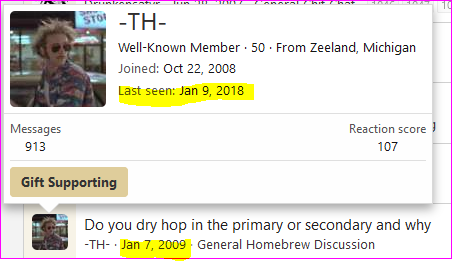-TH-
Well-Known Member
This may be a really dumb question but I noticed almost everyone uses secondary for dry hop, even the primary-only folks (of which I am a recent joinee) and I haven't figured out why. Can anyone enlighten me?

I use my carboy so I can free up my bucket for another batch. That's my only reason.
So just open it up and drop in hops? Is floating pellets a problem?I do it in the primary because I have done it both ways and have not noticed any flavor or aroma differences. So doing it in the primary simply saves me a whole step and I have less risk of contamination and less oxygen exposure.
So just open it up and drop in hops? Is floating pellets a problem?
So just open it up and drop in hops? Is floating pellets a problem?
Deleted. I can not get myself involved in another secondary discussion.This may be a really dumb question but I noticed almost everyone uses secondary for dry hop, even the primary-only folks (of which I am a recent joinee) and I haven't figured out why. Can anyone enlighten me?

Haha this is the second time this has happened to me semi recently too. Check the thread born on date has now been added to my SOPOver time, one learns to check the packaged on dates for malt extract, the started on dates for the thread, ...
View attachment 712266
You’d be surprised how many still do and argue to they are blue in the face that secondaries positively benefit or have no effect on their beer. 4 page active thread going right now of a back and forth. I had to ignore and in watch it because it was bringing the worst out of me. You can only bring a horse to water...I don’t think to many home brewers actually rack to a secondary anymore so I take it as after fermentation has ended. This is one of those questions where answers vary like crazy certain hops can cause hop burn if left on to to long and hops to early can cause hop creep leading to higher abv. However most NEIPAs call for hops while fermentation is still happening. What I now do for a neipa is a small dose of dry hop at the very end of fermentation than another 2-3 days later. For everything else I give the beer a week than dry hop it. I try not to let the hops be for more than 5 days.
Enter your email address to join: